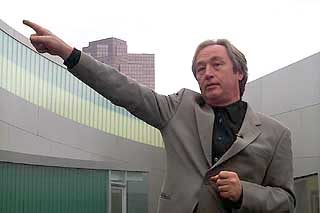|
Subscribe / Renew |
|
|
Contact Us |
|
| ► Subscribe to our Free Weekly Newsletter | |
| home | Welcome, sign in or click here to subscribe. | login |
Architecture & Engineering
| |
December 28, 2000
BAM unveils mysteries of art
Journal Staff Reporter
Thirty-three years after working in downtown Bellevue as a draftsman, Steven Holl has returned as an agent of change.

Photo by Sam Bennett |
Holl, 53, designed the $23 million Bellevue Art Museum (BAM), which officially opens Jan. 13, as a cultural and architectural catalyst for Bellevue.
"What we tried to do with this architecture was to aspire to some kind of new prototype," Holl said. "The whole building had a high aspiration urbanistically."
Located in the heart of Bellevue, at Northeast Sixth and Bellevue Way Northeast, the museum is a symbol of what Holl hopes will be the shape of things to come: a pedestrian-oriented, living downtown where residents can walk to work and to the store.
"I think it sets a new standard of design in Bellevue," said museum director Diane Douglas. "It is one of the first buildings that is really conscientious of the urban environment. It's made of a third of glass, so it welcomes people to look in to see what's happening. At night, that glass becomes a beacon in the community -- a source of radiance and an invitation when a lot of the urban glass towers around it are silent."
Holl is known in the Northwest for his design of the Chapel of St. Ignatius at Seattle University. With BAM, Holl rose to the challenge of an ambitious program of art exploration, education and display. Those elements are the basis of Holl's concept of "tripleness," which dictate the form and function of the building -- from its three gallery lofts, to its three "light qualities," three colors, three levels and three circulation directions.
The third-floor exhibit spaces exploit the possibilities of natural light -- a priority for the Bremerton-born Holl. The geometry of the gallery lofts corresponds roughly to the arc of the sun at 48 degrees north latitude. "The potential of light is not taken away, it's given," said Holl.
While some museums turn a cold shoulder to natural light, Douglas said BAM celebrates a new style. "The age of modernism said the ideal space for showing art is a white box hermetically sealed from the world," she said. "We no longer desire to disconnect art from the world."
|
- Diane Douglas |
The circular trip through the East, North and West galleries ends with an invitation to the Court of Light -- an elliptical terrace Holl touted as the building's fifth facade. Holl recognized that the facade would offer an intriguing view of BAM to workers and residents in the yet-unfinished Lincoln Square -- an adjacent mixed-use development designed by his University of Washington architecture classmate James Cheng.
While the third floor has 8,500 square feet of exhibition space, the second floor is dedicated to the creative process, with 4,000 square feet of classroom space, an artist-in-residence studio and the 900-square-foot Explore Gallery. The floor also houses the library, administrative offices and the Terrace of Planetary Motion -- one of six terraces that open the museum to the street level.
Douglas said the second floor functions as a window on the "engaging, sometimes tumultuous" artistic process. "The simple premise is to take all of that which is normally behind the scenes and only accessible to very few people and bring it to the forefront," she said. "This museum was created to celebrate and explore the creative process."
Even the third-floor gallery spaces evoke the struggle to turn inspiration into art. "It's kind of an art barn," said Holl. "It's meant to have rough floors. The cracks in the black cement are acceptable because that's the nature of the place. It's really a place of experimentation -- not a museum in the sense of a polished, granite and brass rail thing. It's much more of a tool for working with art."
For the exterior, Holl went with an equal combination of glass, hand-sanded marine aluminium and stained red concrete. The geometrically cut western facade is a stark contrast to the circular route taken to the gallery space. "The key is the screw movement of your body, moving all the way through the museum," he said. When he first began work on the project, Holl said he used the Seattle Art Museum design as a model of what to avoid -- lack of natural lighting and poor routes to gallery spaces, he said.
Because the museum will have no permanent collection, Holl said the project had a "mysterious" appeal that would offer a once-in-a-lifetime opportunity. "This is a unique project because the program was unique," he said. "This building could only happen here, and it won't happen again in my career."
The museum will be featured on "Charlie Rose" on PBS at 12:15 a.m. Saturday. The associate architect is Sclater Partners. Sellen Construction was the general contractor, and the engineer was Skilling Ward Magnusson Barkshire.


